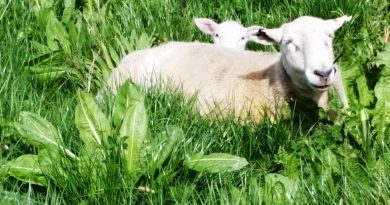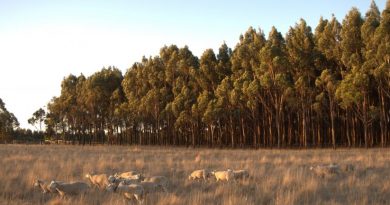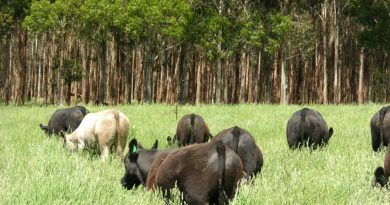2020 spring update: pasture and lamb bonanza
By Patrick Francis
It is difficult to comprehend just how good the 2020 year has been for pasture growth, sheep health, and fertility. The last time we had a year such a good rainfall year was 2011/12 when our livestock enterprise was yearling cattle finishing. In 2012 we changed over to a self-replacing Wiltipoll sheep flock.
From the start of January through to the end of November, rain has been regular every month allowing both our year round green perennial pasture species and winter/spring active perennials to grow to their full potential.
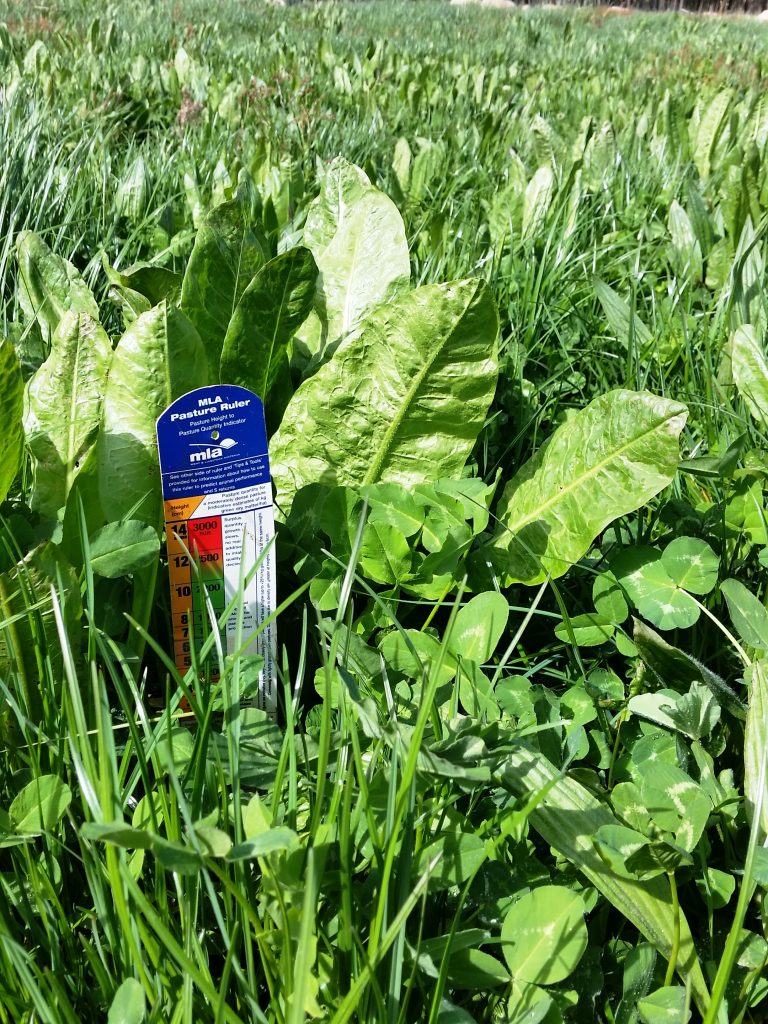
Figure 1: Chicory clovers perennial ryegrass pasture being grazed by ewes and lambs 22 September 2020. Note double length pasture ruler so feed is approximately 28 – 32 cm high.
Pasture production per hectare has been so good this spring that we have:
* not grazed five paddocks for the entire late winter/spring period
* included two extra paddocks in the pasture renovation program – in other words another two paddocks not available for grazing
* have achieved enormous pasture growth in our two dedicated agroforest which normally have limited grazing potential – in effect we gained two additional pasture paddocks.

Figure 2: With such high pasture growth per hectare an additional two ‘old’ pastures were prepared for renovation starting with a knockdown spray, then a cool burn to remove surface herbage to allow direct drilling a forage brassica. Photo: 18 November 2020.
The paddocks not grazed over the winter/spring period since lambing commenced in early August are actually the ones most recently renovated and have the highest potential pasture production per hectare and annual livestock carrying capacity. This may seem counter intuitive but my reasons were:
* The most recently renovated pasture paddocks (since round two of pasture renovation started in 2017) have the most to gain as far as long-term resilience of perennial grasses is concerned by being allowed to grow their roots to potential, increase crown diameter to cover more surface area between plants, and set seed.
* For the same reason the sub clovers and perennial clovers planted in the mix have an unusual opportunity to grow deeper roots, encourage rhizobia root nodule production for symbiotic nitrogen fixation, and increase seed production.
* The older first round pasture renovation paddocks (renovated through 1990s – early 2000s) have a higher proportion of less desirable species (sweet vernal, bent grass, Yorkshire fog, cape weed) alongside desirables like cocksfoot, tall fescue, phalaris, ryegrass and sub clovers. All the species combined with such a good monthly rainfall to grow substantial more pasture than usual after each grazing period. In other words they recovered from grazing far quicker and were available for re-grazing sooner than in other years. Using grazing pressure (stocking rates above 80dse/ha) is most important on the less desirable species to keep them from setting seed as spring progresses.
The species not suited to delayed grazing and setting seed is chicory. Our experience over the past three years has shown that chicory should not be able to bolt (set seed) because if it does the plant can rot into the tap root and die. Preventing this has been a challenge since mid November when the chicory begins to bolt. That’s because we want as much chicory as possible in our special finishing paddocks to wean lambs onto in late November. We have achieved average lamb growth rates of up to 400grams per day on chicory dominant pasture.
But we still need to maintain a grazing rotation so some of our chicory based pastures are being grazed with weaners later than is desirable. To ensure we can keep some degree of control on chicory were are limiting its sowing to four paddocks where it dominates the species mix.
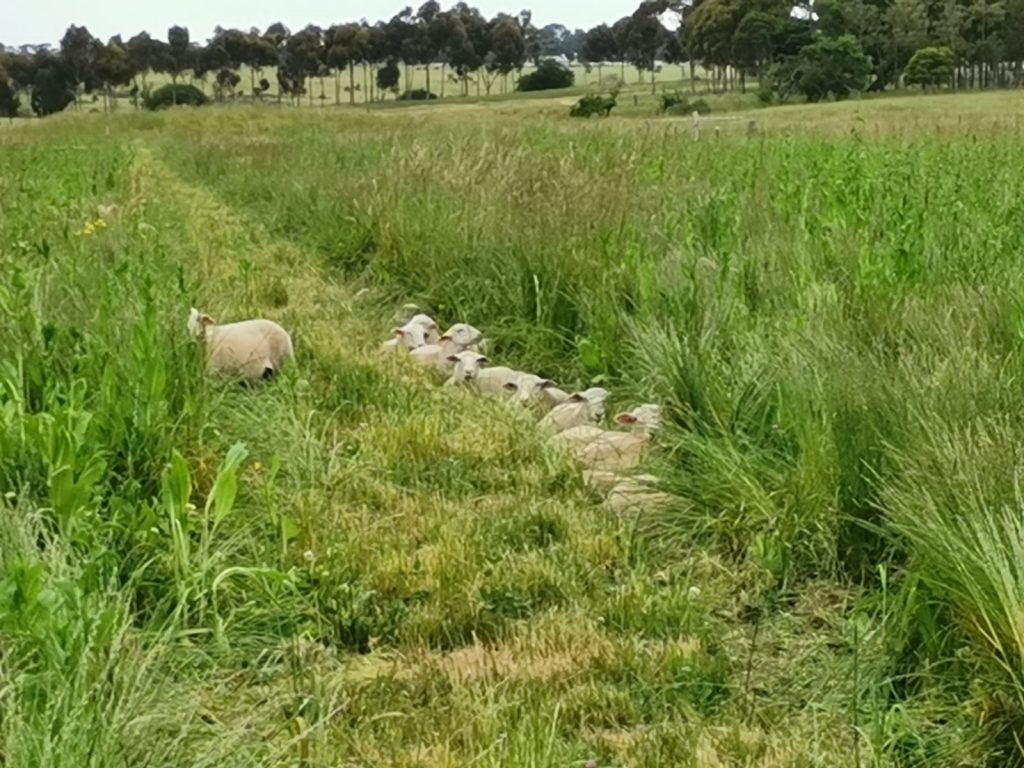
Figure 3: Weaned lambs needed a track slashed through this chicory/clover/perennial ryegrass “finishing” pasture so they could find their way to water troughs. It is same paddock as figure 1 after seven weeks grazing rest. The chicory is beginning to bolt. Estimated pasture mass (at lamb entry) is 5000kg dry matter per hectare. Photo: 22 November 2020.
How much fertiliser
While maintaining recommended levels of plant nutrients and soil pH is part of our management, the older pastures receive only intermittent fertiliser on a nutrient budget basis. There is little nutrient export out of these paddocks through livestock sales. In contrast the chicory special finishing paddocks have significant nutrient export through live weight growth then lamb sales. These paddocks require annual fertiliser application to prevent nutrient mining.
However, what this year of even rainfall each month has shown is how plant growth also relies on nutrient mineralisation via soil biology. While during winter and early spring there is little mineralisation happening because the soil is too cold, the mineralisation which occurred through summer and autumn in 2020 is likely to have set up a plant available nutrient bank which the perennial grasses and weeds like capeweed took advantage of over winter and early spring.
Another take home message about pastures from 2020’s experience is the myth that sufficient winter pasture bulk needs support from direct sowing annual species such as cereals, forage brassicas and crop legumes (e.g. the Soilkee system). I suspect that the pastures these are being sown into are poor performers in the first place maybe due to the species or existing grazing management.
In our experience if the perennial pasture species mix is diverse and is given appropriate grazing management particularly over summer and autumn then acceptable winter growth is achieved. When average rainfall is consistent every month as in 2020 then pasture growth is exceptional even with the less desirable grasses and broadleaves. Irrespective of rainfall regularity and amount the key to achieving a pasture bank is matching stocking rates to targeted paddock carrying capacities that nature determines throughout the year. When this is understood interventions such as Soilkee are not necessary and cost of production per head and per hectare will be lower.
Lambing percentage highest ever
It won’t surprise readers that given the 2020 pasture growth pattern since January, ewe fertility was also optimum through joining over March/April (five weeks). The scenario was our highest ever lamb marking percentage – 160%. Given the outstanding pasture availability through gestation there was a little concern about the possibility of increased dystocias (difficult births). This did not eventuate and dystocia numbers were similar to other years.
This year we purchased a new electronic scale to provide accurate birth weights of all lambs born. We needed this for our own information and to supply more data the Maternal Carcase Production Lamplan index. The lamb birth weights were:
Ewe hoggets singles: 4.80kg; twins: 3.62kg
Mature ewes singles: 5.16kg: twins: 4.37kg

Figure 4: Lambs were weighed using an electronic luggage scale within 6 to 12 hours from birth.
It is interesting that with shepherding even the smallest lambs will survive. We had one set of twins born at 2.36kg each to a maiden ewe. She looked after those lambs and we helped with yarding them at night for a week to protect them from fox attack and the lambs thrived. At weaning at 10 weeks of age they weighed 16 and 20kg.

Figure 5: Despite optimum ewe nutrition through pregnancy lamb birth weights were not an issue in terms of increased dystocia due to higher condition score ewes. This maiden ewe gave birth to twins weighing just 2.36kg each. They survived and grew at average growth rates of 200grams per day from marking to weaning on 22 November. Photo: 13 September 2020.
Foxes were a major concern. Baiting (1080 Foxoff) started four weeks before lambing and continued for 10 weeks. A total of 74 baits were taken. Foxes were occasionally seen in paddocks adjacent to lambing ewes but none were shot. No lambs were taken by foxes.
There were no lamb deaths related to weather exposure despite severe conditions at times during August where the wind chill dropped below OC (common during winter at Romsey where altitude is 470m above sea level).
Lamb weaning was undertaken a week earlier than usual because of reasonable lamb growth rates and outstanding chicory/clover/ryegrass pasture available to wean into. Average weaning weight was 26kg and average growth rate to weaning 204grams per day. Average lamb growth rate from birth to lamb marking was 306g/day. This indicates to us that ewe lactation peaks at around six weeks from birth then declines significantly taking with it lamb growth rate performance.
Taking a closer look at the growth data between marking and weaning we found that about 40% of ewes had lambs which maintained or increased growth rate post the six weeks. This suggests that some ewes (about 10%) have a propensity to maintain high milk production for longer during the lactation and their lambs subsequently benefit with higher weight gains. A further 30% of ewes drop milk production slightly post marking with their lamb growth declining only marginally between marking and weaning.
Combine this “lactation” lamb growth rate data with ewe condition scores at weaning and there could be scope to boost across flock milk production performance with ewes able to maintain their body condition through lactation.
Anecdotal evidence suggests this is the case as I can identify individual ewes who approach the shepherd at any time. Two well-known similar mature size ewes produced twin female progeny and gave birth in condition score (CS) 3.5. At weaning both ewes progeny averaged 30kg live weight each, but one ewe had a CS of 3 and the other a CS of 2.5. The latter ewe has a greater challenge to regain weight at joining. This is not an issue in an above average rainfall year such as we are having, but if rainfall is marginal as in summer autumn 2019 the lower condition score ewe will struggle to achieve a high fecundity CS at joining in mid-March grazing pasture alone.
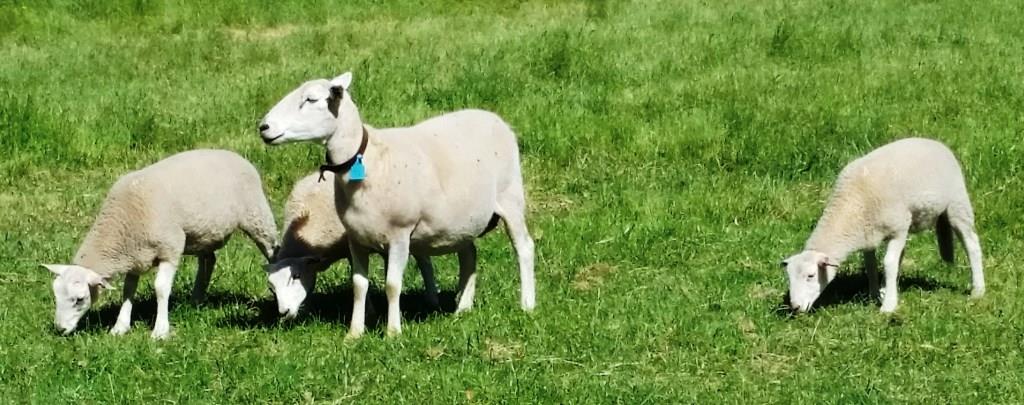
Figure 6: Ewe lactation resilience is demonstrated in Blue 72 who had triplets then weaned her three lambs with combined total body weights, 60kg, similar to her own weight, while maintaining a CS 3. Between lamb marking and weaning the combined average lamb growth rate was 317grams per day. Photo: 20 November 2020.
As we endeavour to maintain a pasture only grazing system (no supplements of hay, silage or grain at any time) breeding resilient ewes which maintain body weight during lactation is an important genetic trait to evaluate and include in the genetic trait selection mix.
Analgesia at castration
A new initiative this year was to use the analgesic under veterinary supervision when castrating males with rubber rings. We stopped docking lamb tails in 2016 and observed at the time that males which were castrated with rubber rings displayed far less discomfort compared to when the rubber rings were used for castration and for tail docking. New Zealand research has demonstrated this effect measuring blood cortisol levels which indicated the stress level measured on male lambs castrated versus castrated and tail docked with rubber rings was far lower (about half the rise in blood cortisol level).
Despite this we were still concerned about the discomfort the male lambs displayed after castration and spoke to our local vet. He suggested direct injection of analgesic into each testis would be a solution. Under his supervision to supply the S4 lignocaine analgesic and recommended dose rate, we set up a comparison trial of treated versus untreated lambs.
Our visual observation of the behaviour of analgesic treated males versus untreated males quickly convinced us that analgesia will be standard practice on Moffitts Farm from now on. The commercially available technology to inject lignocaine is available via Numnuts (also with analgesic supplied under veterinary supervision) but we opted for the slower method of using a syringe to inject the analgesic. With a small flock there is no rush involved with lamb marking so the injection system is not an impost. We also weigh each lamb at marking.
Growth rate data between marking and weaning in the analgesic trial shows no weight gain difference between those given analgesic before the rubber ring is applied (225.24g/day) and the controls with no analgesic (224.70g/day). Despite no detectable growth rate differences between analgesic treated and untreated males, we noticed some behaviour stress in the untreated group so we have decided that to ensure optimum animal welfare castration, analgesia for castration will be standard practice on Moffitts Farm from now on.
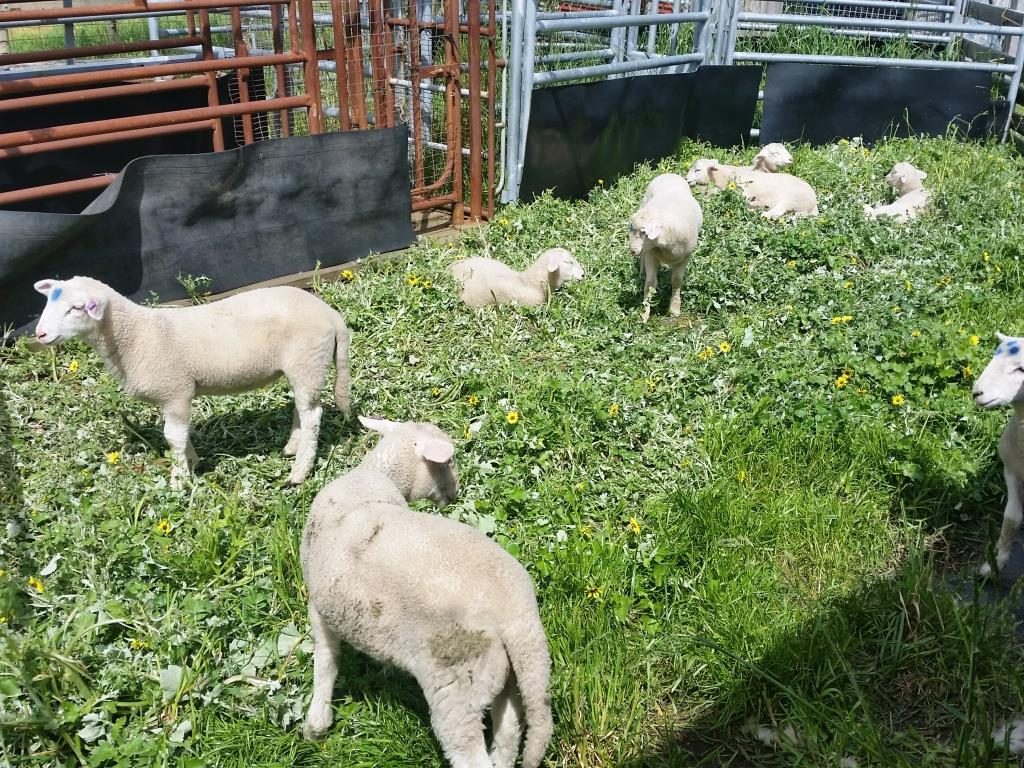
Figure 7: These lignocaine treated male lambs showed no signs of discomfort immediately after ring castration. In the comparison between treated and untreated males there was no effect of the analgesia on lamb growth rates between marking and weaning.

